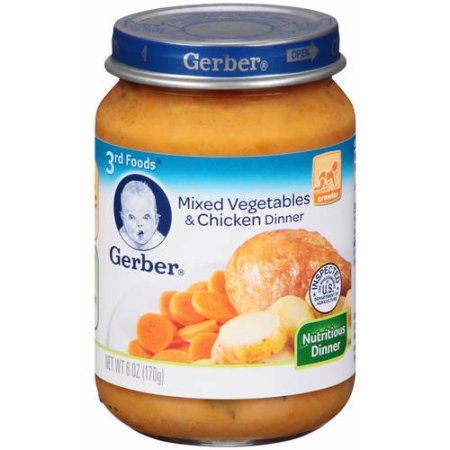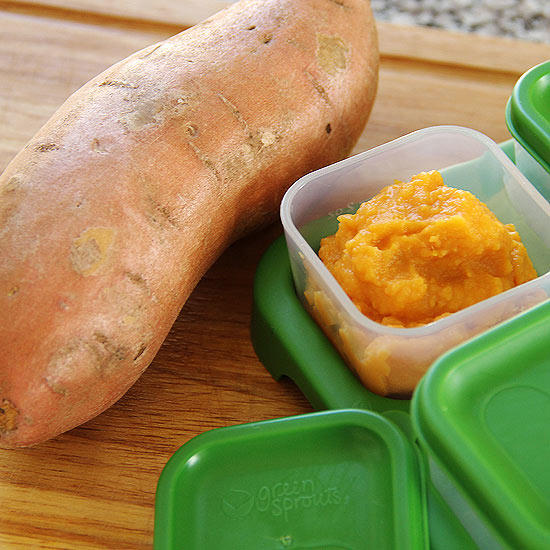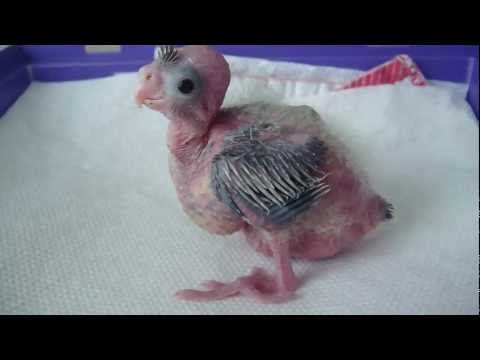When to stop feeding baby pureed food
When to end purees and start soft table foods with your infant
Julia was delighted to begin solid foods with her 6-month-old son Brandon. Brandon was a champion eater and quickly learned to manage the iron-fortified rice cereal fed to him from a spoon. As Brandon grew, Julia began introducing pureed foods to provide a more balanced diet in addition to breast milk. By 8 months, Brandon grew impatient for his mother to spoon purees into his mouth. At 10 months, Brandon was communicating he was hungry even though he had eaten three bowls of puree an hour earlier. Julia was wondering why her son had such a veracious appetite and wasn’t content after eating
It is a pleasure to introduce infants to the new tastes of solid foods at 6 months of age. Watching their little tongues learn to move food from the front to the back of their mouths to swallow is mesmerizing. And as soon as they have mastered this skill, parents love to start introducing other foods in pureed form, such as fruits and vegetables. Later, protein sources such as meat, fish, or legumes are also added to the purees to provide a balanced diet in addition to breast milk or formula.
However well intentioned, some parents continue to provide purees rather than moving onto solid table foods because:
they fear that their baby won’t eat enough;
their baby will not be able to mash the soft foods with their gums;
their baby will choke on non-pureed foods; or
the parent enjoys spending time feeding their little one with a spoon.
Reasons such as these may lead parents to offer purees longer than is recommended.
Breastfeeding Bootcamp
Includes 16 lessons.
It doesn’t matter whether you are a new mom or if this is your second or third child: breastfeeding is not always easy. Each baby is unique, and your body is also…
View contents
Newborn Care
Includes 8 lessons.
The first three weeks of life are key to your baby’s development. What the newborn feels during this time constitutes their first experience of the world, and will…
View contents
Baby cereals and purees are only needed during the first months of learning to eat solid foods.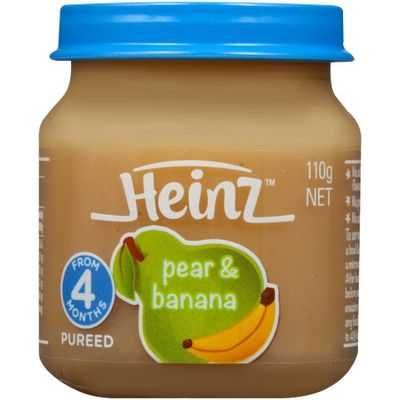 Babies need to learn to control their tongues to move the food from the front of their mouths to the back of their mouths to swallow. Purees allow them the perfect consistency to master this skill. The next step is for them to accept food into their mouth and learn to chew the food with their gums before swallowing. This natural transition from swallowing a liquefied food (puree) to breaking down soft foods (chewing) helps prepare babies for feeding themselves independently.
Babies need to learn to control their tongues to move the food from the front of their mouths to the back of their mouths to swallow. Purees allow them the perfect consistency to master this skill. The next step is for them to accept food into their mouth and learn to chew the food with their gums before swallowing. This natural transition from swallowing a liquefied food (puree) to breaking down soft foods (chewing) helps prepare babies for feeding themselves independently.
When parents continue to offer purees rather than soft table foods, there are a few issues that can arise, including:
Babies take a passive role in eating because the parent is directly involved with spoon-feeding. This can interfere with the baby’s natural hunger and satiety responses;
It can be difficult for babies to accept foods with different types of textures because they are not used to feeling all the unique ways that solid foods feels in the mouth;
Babies can choke if they think they are supposed to swallow everything in their mouth without chewing. They need time and practice to learn to chew before swallowing; and
They need time and practice to learn to chew before swallowing; and
Purees pass through the stomach faster than solid foods because they are already partially broken down before being swallowed. This can lead to feelings of hunger and stress about when the next offering of food will occur.
To help your baby avoid these and many other issues around feeding, it is recommended that purees are phased out and soft, solid foods are introduced as soon as your baby can move foods easily from the front of their mouth to the back to swallow. This usually happens for most infants by 6-8 months of age. After your baby has mastered this skill, you can start providing foods that the rest of your family is enjoying. You can offer well-cooked, mashed, or ground fruits and vegetables, mashed potatoes, sticky rice, or wheat-free dry cereals like Cheerios that have been broken in half in addition to breast milk or formula.
By 7-10 months, most infants are able to eat chopped cooked vegetables, canned or cooked fruits, cheese, mashed cooked dried beans, strips of toast, crackers and dry cereal, as well as breast milk or formula.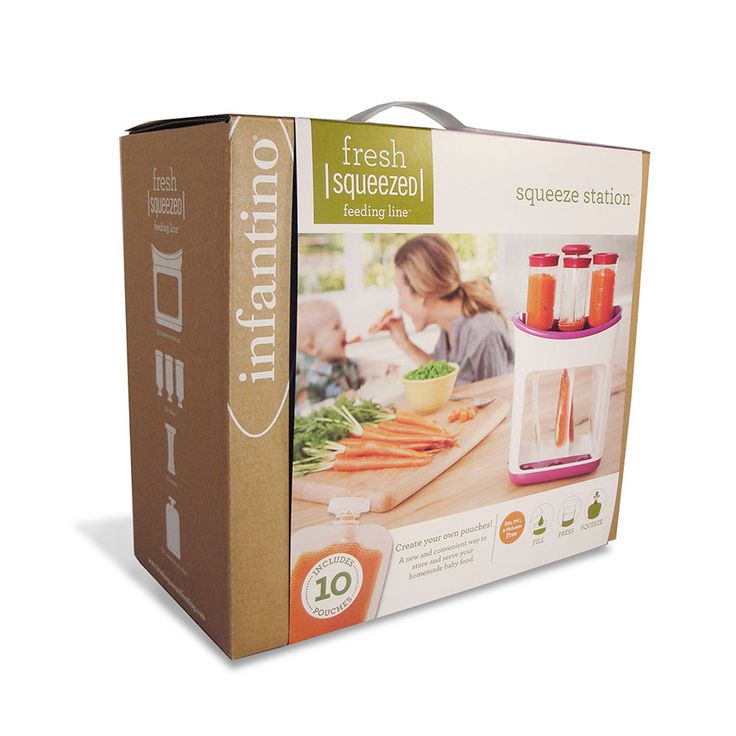 And by 9-12 months, most babies can eat cut up soft cooked foods, cut up soft foods like bananas or peaches, tender chopped meats, dishes with noodles that are cut up, dry cereal, toast, crackers, eggs, and cheese, in addition to breast milk or formula. This progression is to prepare your baby to move onto being a toddler on their first birthday and be able to eat everything from the family table that is soft. Remember to avoid foods that can cause choking like whole grapes or sausage rounds. Meat should continue to be cut up into small pieces. Whole pasteurized milk can be given in place of breast milk or formula.
And by 9-12 months, most babies can eat cut up soft cooked foods, cut up soft foods like bananas or peaches, tender chopped meats, dishes with noodles that are cut up, dry cereal, toast, crackers, eggs, and cheese, in addition to breast milk or formula. This progression is to prepare your baby to move onto being a toddler on their first birthday and be able to eat everything from the family table that is soft. Remember to avoid foods that can cause choking like whole grapes or sausage rounds. Meat should continue to be cut up into small pieces. Whole pasteurized milk can be given in place of breast milk or formula.
How to Keep Your Teen From Becoming a J@ck@$$
Dr. Deanna Marie Mason PhD
This practical hands-on book explains how to help teens in the process of finding themselves as they grow into adulthood. It is a unique, special guide because it shares teens’ perspectives on what they need to become the people of their dreams…
View contents
Proactive Parenting: How to Raise Teenagers with Values
Dr.
 Deanna Marie Mason PhD
Deanna Marie Mason PhDCyberbullying, sexting, alcohol, drugs, unwanted pregnancies, bullying, academic disinterest, and eating disorders are just some of the worries parents face today. However, these situations or behaviors can be avoided if children are educated in values…
View contents
Allowing your baby to grow and adapt their eating habits during the first year of life, as their development permits, will set them up to learn to accept and enjoy a wide variety of foods that support a healthy diet. They will also learn to take more control over eating enough food to keep their bodies satisfied between meals and snacks. Encouraging your baby to transition from purees to solid foods is a wonderful way to support their growth and development.
Sources:
Satter, E. (2000). Child of mine: Feeding with love and good sense. Boulder, CO: Bull Publishing Company.
Swarzenberg, S. Georgieff, M. & Committee on Nutrition. (2018). Advocacy for improving nutrition in the first 1000 days to support childhood development and adult health.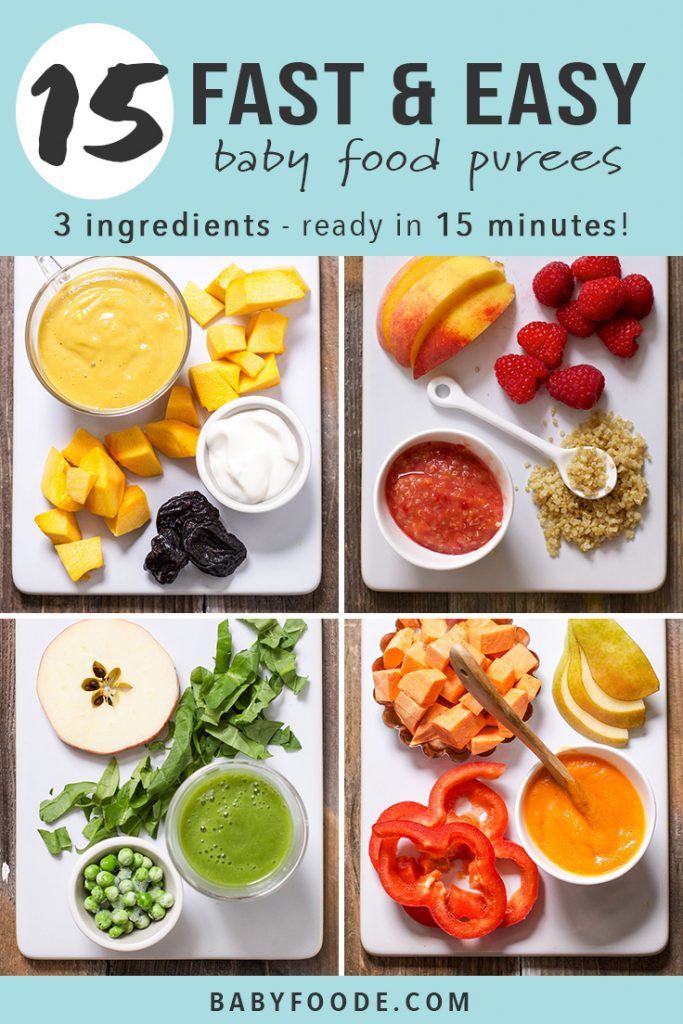 Pediatrics 141(2), doi: 10.1542/peds.2017-3716.
Pediatrics 141(2), doi: 10.1542/peds.2017-3716.
World Health Organization. (2003). Feeding and nutrition of infants and young children: Guidelines for the WHO European Region. Denmark: WHO Region Publications.
Share article
About the instructor
Proactive Parenting
Dr. Deanna Marie Mason PhD
More than 20 years of clinical experience helping families:
Bachelor's Degree in Registered Nursing, Master’s Degree in Pediatric Nurse Practitioner and PhD in Nursing. University professor, patient education specialist, pediatric researcher, published author and reviewer to first-line international scientific journals, continuous philanthropic activity related to health promotion and education, wife and mother of two children.
When to Stop Pureed Food for Infants | Healthy Eating
By Krista Sheehan Updated December 12, 2018
Knowing when to stop pureed foods in your baby's diet isn't as easy as knowing when to change his diaper.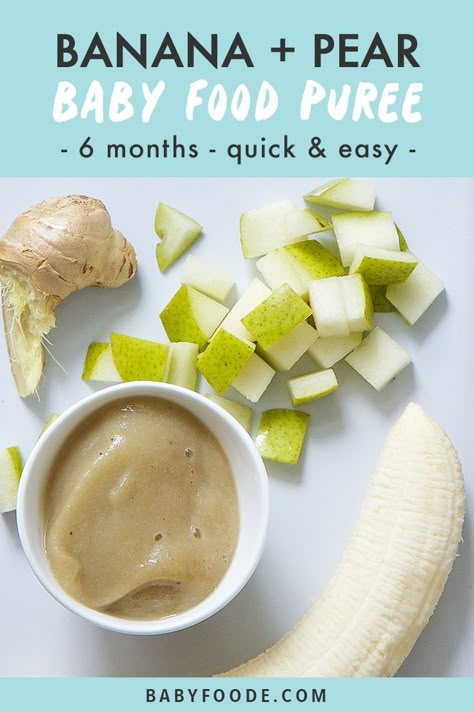 There is no one-size-fits-all rule for feeding your baby -- but he'll let you know when he's ready. Adding pureed foods to your baby’s diet at around 4 months of age introduces a new world of tastes and textures. But knowing when to stop pureed foods -- usually around 1 year of age -- is important for helping your baby develop chewing and swallowing skills.
There is no one-size-fits-all rule for feeding your baby -- but he'll let you know when he's ready. Adding pureed foods to your baby’s diet at around 4 months of age introduces a new world of tastes and textures. But knowing when to stop pureed foods -- usually around 1 year of age -- is important for helping your baby develop chewing and swallowing skills.
Developmental Timeline
Typically, infants are started on pureed foods between 4 to 6 months of age. In the beginning, choose pureed foods with only one ingredient. As the infant becomes more accustomed to the new texture, include pureed foods with a combination of ingredients -- this typically occurs around 6 to 8 months of age. As your baby moves into the 8- to 10-month time frame, chunkier pureed foods can be introduced. If your baby does well with these foods, introduce soft, cooked vegetables and cooked fruits, breads, soft cereals, scrambled eggs and yogurt around 10 to 12 months of age. If your baby manages these soft foods easily, stop pureed foods. Ideally, your baby should not be eating pureed foods after 1 year of age.
If your baby manages these soft foods easily, stop pureed foods. Ideally, your baby should not be eating pureed foods after 1 year of age.
Baby’s Readiness Cues
Your baby will give you certain clues that indicate he’s ready for solid and finger foods. These cues might include picking up foods with his thumb and forefinger, easily transferring items from one hand to the other and moving his mouth in a chewing motion. Your baby will also be ready to stop eating pureed foods as he develops more teeth and gains more control of his tongue. However, if you attempt to stop pureed foods at 12 months and your baby is struggling with solid and finger foods, adding pureed foods back into the diet might be necessary. Consult your pediatrician if you have any concerns or questions about your baby’s specific diet.
Allergy Considerations
When adding new foods to a baby’s diet, add only one new ingredient at a time. This feeding plan allows you to more easily identify a baby’s allergies or sensitivities to specific foods. Allow your baby to eat the new ingredient for a few days -- unless an allergic reaction occurs, of course. If no reactions occur after a few days, you can safely add another new ingredient to your baby’s diet.
This feeding plan allows you to more easily identify a baby’s allergies or sensitivities to specific foods. Allow your baby to eat the new ingredient for a few days -- unless an allergic reaction occurs, of course. If no reactions occur after a few days, you can safely add another new ingredient to your baby’s diet.
Foods to Avoid
Certain foods and ingredients should be completely avoided in a baby’s diet. According to the Florida Department of Health, your baby should never be given pureed foods made with honey, corn syrup, added sugar, artificial sweeteners, spices, seasonings or salt.
References- March of Dimes: Feeding Your Baby
- Cooking Light: Baby Feeding Timeline
- BabyCenter: Age-by-Age Guide to Feeding your Baby
Krista Sheehan is a registered nurse and professional writer. She works in a neonatal intensive care unit (NICU) and her previous nursing experience includes geriatrics, pulmonary disorders and home health care. Her professional writing works focus mainly on the subjects of physical health, fitness, nutrition and positive lifestyle changes.
Her professional writing works focus mainly on the subjects of physical health, fitness, nutrition and positive lifestyle changes.
What is food supplementation and how to start it
search support iconSearch keywords
Home ›› What is educational food and when can I start it?
Home ›› What is pedagogical complementary foods and when can I start it?
↑ Top
What is pedagogical complementary foods and when can I start it?
One of the important and even a little fun things that your baby has to overcome in the first year of life is learning to chew solid food like adults. If this is your first child, you may be wondering where to start. There are many different approaches, and you may have heard of such a method as pedagogical complementary foods (pedal foods). But, first, let's figure out what types of complementary foods exist.
Types of complementary foods
There are 2 types of complementary foods: energy and pedagogical.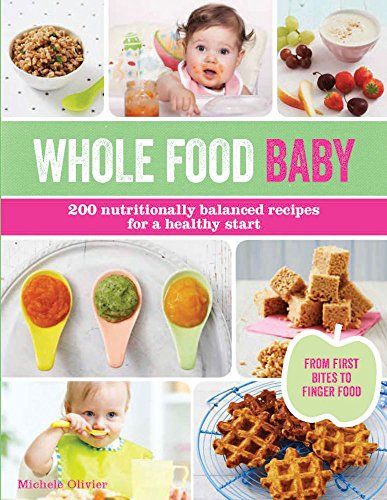
- Energy food is the most popular type of food, it is even called classic. Its main goal is to provide the child with an additional source of energy in the form of new products. With this type of complementary foods, the baby is first introduced to pureed foods or cereals, which gradually replace breastfeeding for the baby. The main feature of this type of complementary foods is that the baby does not develop chewing skills for a long time due to the homogenization of complementary foods.
- Pedagogical complementary food is a type of complementary food that introduces the child to "adult" food, develops his/her food interest and teaches him to eat independently. The main goal of this complementary food is pedagogical, that is, to teach the baby to eat like adults and to show interest in the food of their parents. With this type of complementary food, chewing skills develop much faster, since the stage of mashed food and spoon feeding is completely skipped, and your child begins to eat solid foods right from the table.
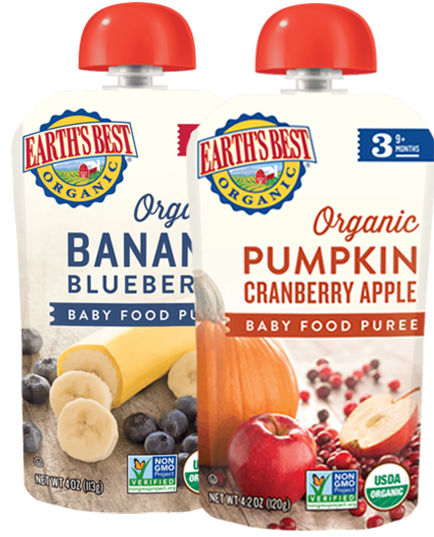
Feeding has many benefits, so we'll walk you through how to get started and give you some practical tips to make it enjoyable for both you and your baby. As always, if you have any questions, be sure to check with your child's healthcare provider.
Learn more about PE
Unlike energy supplements, PE does not have a strict plan for the types and quantities of products. One of the main differences is that nothing is specially prepared for the child. He is offered microdoses of adult food (the size of a rice) to prevent them from getting stuck in his throat (for example, well-cooked vegetables or soft fruits are cut into small pieces). The child himself chooses which products he wants to try from the table, and he takes them with his hands, he is not spoon-fed, as in energy foods. For the first few weeks of complementary foods, the child sits on her mother's lap while eating and tries microdoses of food from her plate. Gradually, the number of microdoses and types of food increases. Thus, there is an acquaintance with new food. Remember that mother's milk remains the main food for the child. We also draw your attention to the fact that this type of complementary foods is usually suitable for those families where they eat properly and varied.
Thus, there is an acquaintance with new food. Remember that mother's milk remains the main food for the child. We also draw your attention to the fact that this type of complementary foods is usually suitable for those families where they eat properly and varied.
Many experts recommend steaming the first “adult” food for a baby, since it is this cooking method that preserves the maximum amount of useful trace elements and vitamins in products, and also because steamed products turn out juicy and retain their taste . Look no further than the Philips Avent 4 in 1 Steamer Blender to help you save time and effort and prepare the healthiest meals for your little one. The Philips Avent steamer allows you to make any consistency of food, from puree to chunks.
Premium
A double-gun 4-B-1
SCF883 / 01General estimate /5
- Reviews reviews
-{discount-value
- Images
What are the benefits of educational complementary foods?
It is believed that when children are introduced to the diet of foods from the general table at an early age, children become more familiar with the texture and taste of these foods, they develop an active food interest. Feeding food is also considered one of the easiest and most natural ways to introduce solid food into a child's diet, since this method does not require special preparation of food, grinding it in a blender: it is enough just to give your baby products from your table in microdoses, and this will allow your child to take part in meals with the whole family.
Feeding food is also considered one of the easiest and most natural ways to introduce solid food into a child's diet, since this method does not require special preparation of food, grinding it in a blender: it is enough just to give your baby products from your table in microdoses, and this will allow your child to take part in meals with the whole family.
An important point here is the established diet of the family.
Here are a few more benefits of complementary food: 1
- development of active food interest and eating behavior;
- development of motor skills;
- child makes independent decisions;
- reducing the risk of overeating and the formation of eating behaviors leading to fullness (leveling habits that further contribute to overweight).
Would you like to try the infant formula? Let's see where to start!
When to start feeding?
According to the infant feeding methodology, solid foods are recommended to be introduced when the baby is six months old.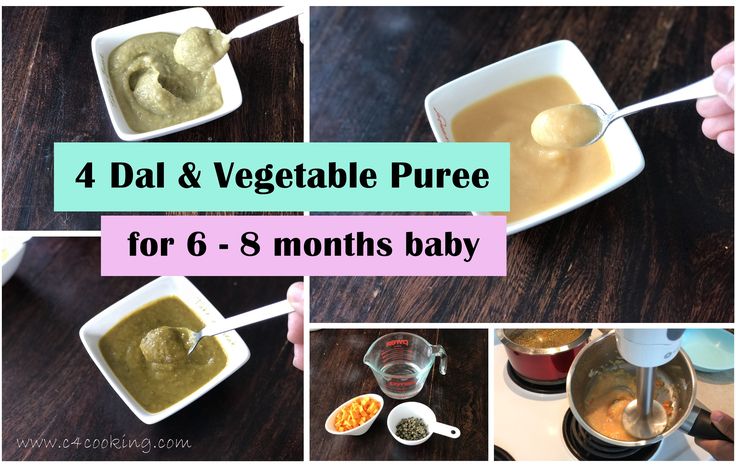 Six months is the ideal time to start complementary foods, as most babies at this age can sit without support and have good control of their neck, head, and motor skills. 2
Six months is the ideal time to start complementary foods, as most babies at this age can sit without support and have good control of their neck, head, and motor skills. 2
If you choose an energy type of complementary food for yourself and your baby, you can introduce mashed food at the age of four to six months. However, it is better to be careful with solid food and wait until your child is six months old to give him solid food in the form of small pieces.
How to start feeding?
To make this transition enjoyable for both you and your baby, let's discuss some aspects of complementary foods. Below is an algorithm and useful tips about infant feeding: 1 2
- Have the child sit at the table. One of the benefits of infant food is that your baby can eat at the table with the whole family. Start with the fact that during lunch, just put the child at the table with everyone.
 In this way, the child will be able to watch all the members of the family when they are eating, and he will develop an active food interest.
In this way, the child will be able to watch all the members of the family when they are eating, and he will develop an active food interest.
- Give your child food that he can handle. Even though your baby is not getting pureed food as part of the infant formula, but is given the food in small pieces right away, you still need to make sure that the food is well crushed and soft enough so that he does not choke. Cut baby food into small, rice-sized pieces that your baby can easily pick up and eat on their own.
Remember to make sure the food is soft enough for your child to chew and swallow easily. Foods like mashed potatoes, beans, well-cooked pasta, and rice are all great food options to offer your little one.
For even more variety in your baby's complementary foods, look no further than the Philips Avent 4 in 1 Steamer Blender to prepare delicious and healthy meals with a variety of recipes. You'll discover new ways to prepare homemade vegetables and meats that the whole family can enjoy, as one jar is enough for several servings.

- Have a glass of water ready. As soon as the child begins to eat on his own, he will also begin to drink on his own. Try using the Natural training cup so that your baby can gradually get used to holding the sippy cup by the handles while drinking from the familiar Natural nipple.
When you start complementary foods, be aware that dinner will get a little messy! As your child learns to pick up food and eat on his own, dropped food pieces will become commonplace, as will cute smudges of food smeared on your child's cheeks.
5. Continue breastfeeding or formula.
And remember that complementary foods do not mean that you should immediately stop breastfeeding or formula. When starting complementary foods at six months of age, think of this time as your baby's introduction to new food textures and flavors. Continue breastfeeding or formula to ensure your baby gets all the nutrients it needs in its first year of life.
 Remember that the main food for him remains mother's milk or infant formula.
Remember that the main food for him remains mother's milk or infant formula. There will come a time when you and your baby will be ready to stop breastfeeding. You can find out when and how to do this here.
Now that you know what infant foods are and have a few recommendations in your arsenal about including food from the common table in your baby's diet, you can sit at the table with the whole family! Yes, there will be some confusion, but this is only part of a long journey that you and your child are walking together.
Philips Avent Articles & Tips
1 Contemporary Pediatrics - Baby-led weaning: Introducing complementary foods in infancy
2 National Library of Medicine - Baby-Led Weaning: The Evidence to Date & The American Academy of Pediatrics (AAP) - A Baby-Led Approach to Eating Solids and Risk of Choking
Baby+ App
Download app and track with trackers the development and growth of your child, and to keep those special moments forever.
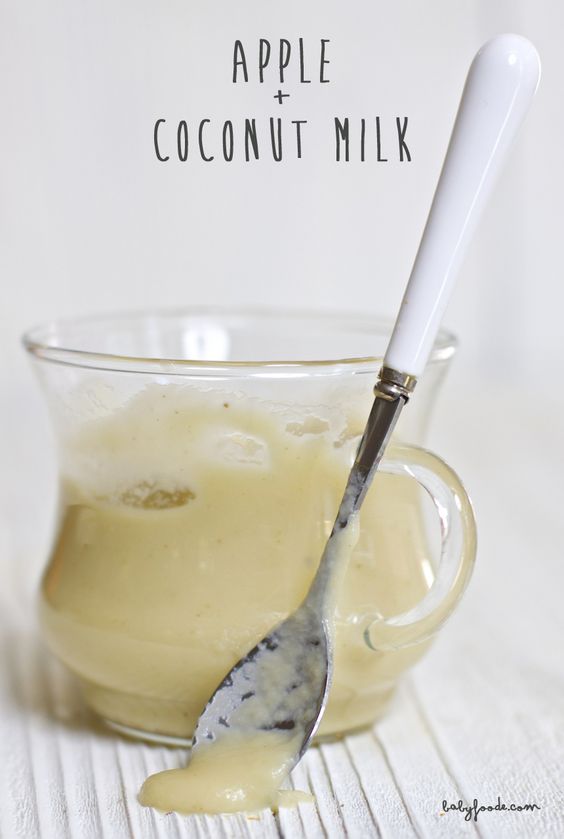
Download app:
You are leaving the Philips Healthcare (“Philips”) official website. Any links to third party websites that may be included on this site are provided solely as a convenience to you. Philips makes no warranties regarding any third party websites or the information they contain.
I understand
You are about to visit a Philips global content page
Continue
You are about to visit the Philips USA website.
I understand
Complementary foods | Medical Center "Beloved Doctor"
For the first six months, the best source of nutrition for a child is mother's milk. It contains all the necessary elements for the full development of the child in this age period. In some cases, when the mother cannot breastfeed, the baby is fed with special mixtures.
However, after that, the baby needs to expand the diet for the full growth and development of the body.

Complementary food is a range of foods that a child should receive in addition to mother's milk and formula after the first six months of birth. Foods that are denser than milk can be used as complementary foods. Complementary foods contribute to the gradual transfer of the child to the common table. However, it should be remembered that complementary foods are not the basis of a child's diet in the second half of life, the main food product is still milk and milk formulas. But already after the first year of birth, dense and thick food becomes the main food, and milk and milk mixtures become an addition to the food.
Complementary foods can be divided into two types:
- Complementary foods for the transitional period. These are products designed to meet the specific nutritional or physiological needs of the infant.
- Homemade food. These are products intended for young children, which are also included in the diet of all family members.
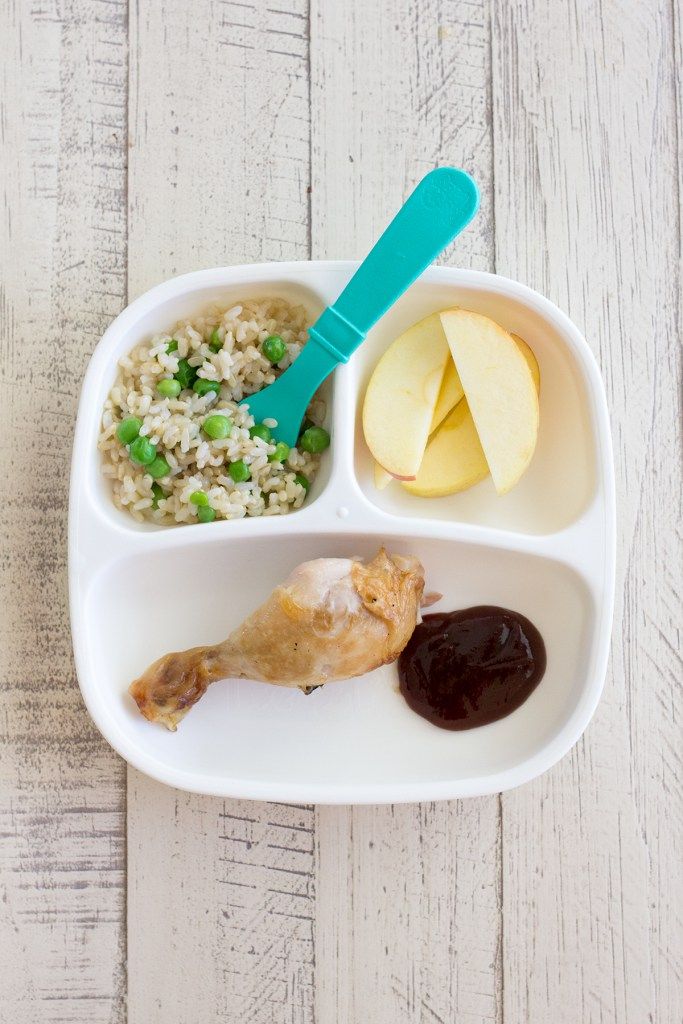
There is also the concept of "supplementary feeding". Supplementary feeding involves additional nutrients that are given to a child up to six months, that is, before the introduction of complementary foods. Supplementary feeding is used to correct nutrition in a number of diseases in children.
Complementary feeding goals
- Over time, the child needs additional energy, vitamins and microelements for proper growth and development. When introducing complementary foods, the child's daily calorie requirement should be taken into account. Energy is spent more intensively, but the daily food intake is limited. Therefore, it is necessary to provide the child with food with a higher density and calorie content. The volume and frequency of complementary foods is gradually increased.
- The transition from liquid food to food from the family table.
 It's over, right away the child will not be able to eat homemade food. Therefore, at 6 months, the child needs to gradually introduce foods adapted for this age. Complementary foods should be denser than breast milk or formula, but not too thick for the baby to swallow. In this case, mashed dishes are perfect as complementary foods, which can be prepared without problems using blenders and mixers. By 1-1.5 years, complementary foods are replaced with homemade food.
It's over, right away the child will not be able to eat homemade food. Therefore, at 6 months, the child needs to gradually introduce foods adapted for this age. Complementary foods should be denser than breast milk or formula, but not too thick for the baby to swallow. In this case, mashed dishes are perfect as complementary foods, which can be prepared without problems using blenders and mixers. By 1-1.5 years, complementary foods are replaced with homemade food.
When to start complementary foods?
- The weight of the baby before weaning should be at least 2 times its birth weight.
- Baby stops spitting out solid food. In infancy, children have an expulsion reflex of the tongue: the child automatically sticks out his tongue if something different in consistency from the usual food (milk or mixture) enters his mouth. This reflex protects infants from the threat of choking on a foreign body. If the child swallows, and does not spit out thicker food (porridge or mashed potatoes), then complementary foods can be introduced.

- The child shows interest in food, becomes more active and opens his mouth at the sight of food, and also, asks to be held at the table, tries to taste the food.
- The child sits confidently.
- The first teeth appear in the child.
It is optimal to introduce complementary foods at 5-6 months.Early introduction of complementary foods is not recommended for the following reasons:
-
- If breastfeeding is replaced with complementary foods at an earlier age, then the mother's production of breast milk may be reduced. The intestines of children are not ready for the introduction of any other food. Complementary foods may increase the risk of bowel disorders, allergies, etc.
Late introduction of complementary foods (after 6 months), undesirable for a number of reasons:
-
- Milk and formula cannot fully provide the baby with energy, vitamins and microelements.
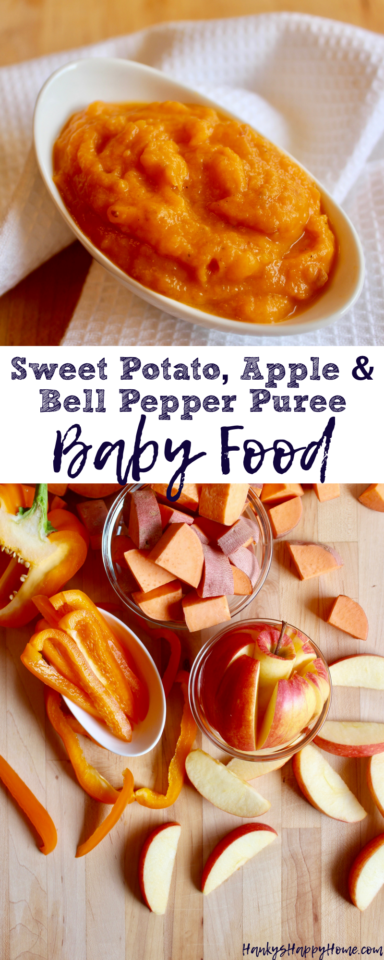
- Milk and formula cannot fully provide the baby with energy, vitamins and microelements.
-
- Chewing skills do not develop.
-
- Growth and developmental delays may occur.
- Delays in psycho-emotional development.
The timely introduction of complementary foods will strengthen the health of the baby and will contribute to its proper development.
Complementary feeding rules
1. Complementary feeding should begin when the baby is healthy.
2. Do not start introducing complementary foods at the time of routine vaccinations.
3. Complementary foods should be given with a spoon, not through a nipple.
4. Until the first year of life, salt, sugar and other seasonings should not be added to complementary foods.
5. New products should be introduced in small quantities, gradually increasing them. Complementary foods should be started with the introduction of one product, gradually moving to mixtures of 2 or more types.
 If you have an allergy or intestinal disorders to certain types of products, you need to stop taking them. You may not have grown up to them yet. It is best to keep a food diary and record in it all the foods introduced into the diet and reactions to them.
If you have an allergy or intestinal disorders to certain types of products, you need to stop taking them. You may not have grown up to them yet. It is best to keep a food diary and record in it all the foods introduced into the diet and reactions to them. 6. Complementary foods should be given warm.
7. From the age of 6 months, you can sit your baby at the table with his own set of cutlery.
8. From the age of 7 months, gradually accustom the child to drinking cups.
9. Complementary foods should be porridge or puree. Larger and harder foods should be given later in life.
10. Diet should be varied. Cereals, vegetables, meat are the main products that should be present in the diet.
11. From 8 months you can give food containing small soft pieces. In the daily diet of a child, there should be at least 3 feedings with thick food (up to half a kilogram in total).
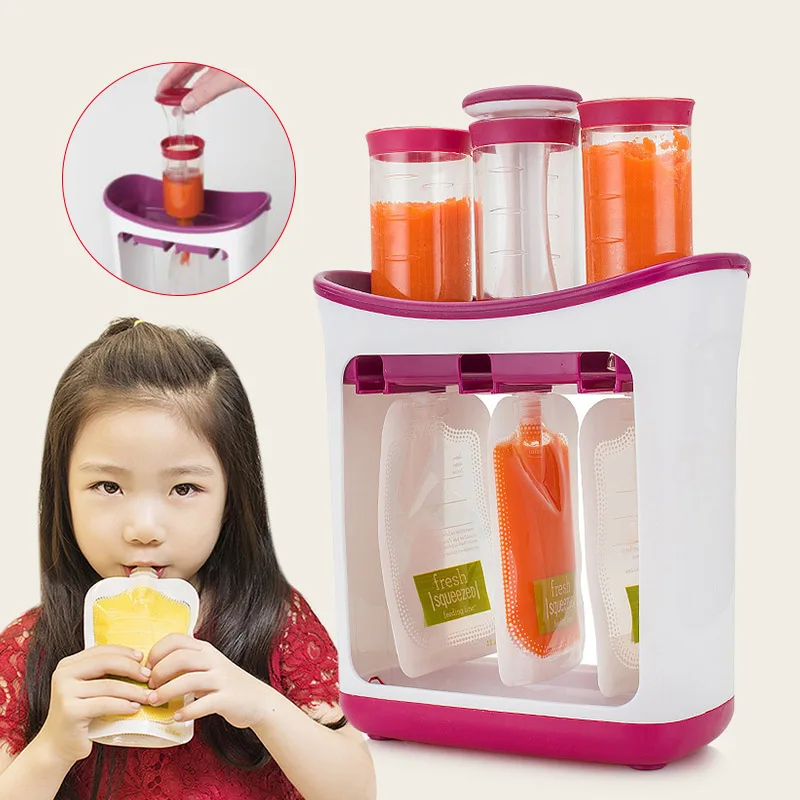
Complementary feeding schedule
5-6 months
This is the time to start complementary foods. You need to start it with cereals and vegetable purees, consisting of one type of cereal or vegetables. It is best to use rice, buckwheat or corn grits cooked in water. Vegetable purees are best made from cabbage, potatoes or zucchini, ground with a blender. The serving should not exceed 100-150 g.
7 months
You can make puree from several types of vegetables that are already familiar to the baby. You can also cook vegetable puree soup by adding vegetable oil.
8 months
Start adding fruit purees to your diet. For starters, you can use fruits such as apple, pear, peach. Fruit purees can be mixed with porridge. However, a portion of vegetables and fruits should not exceed 100-120 g.
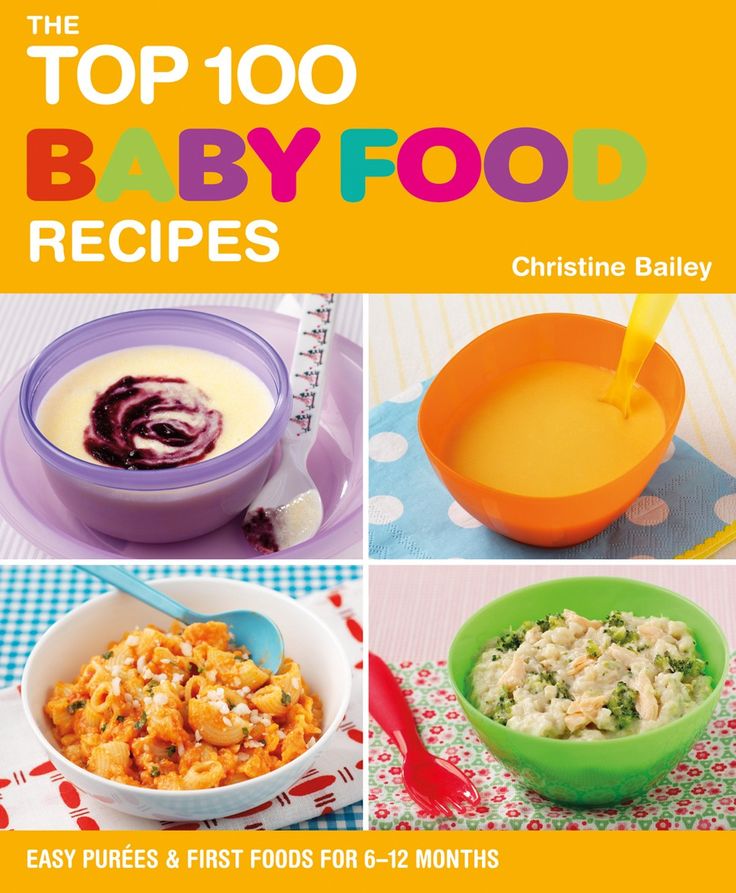 If you gave your baby 60 g of vegetable puree, then fruit puree should also account for no more than 60 g.
If you gave your baby 60 g of vegetable puree, then fruit puree should also account for no more than 60 g. At this time, you can start giving your child kefir and cottage cheese. It is best if these products are prepared at home.
9 months
Complementary foods containing meat can be started. It is better to use beef, rabbit or turkey. Lamb up to a year can cause allergies. The meat must be boiled or steamed and mashed using a meat grinder or blender. You can also buy ready-made canned meat for children. To begin with, meat puree can be mixed with vegetable puree, in which there will be less than one teaspoon of meat puree. Gradually, you can come to 3-4 teaspoons of mashed meat per day (50 g).
10 months
Meat is constantly present in the diet. One or two days a week, instead of meat, you can give your child fish in the same grated form.
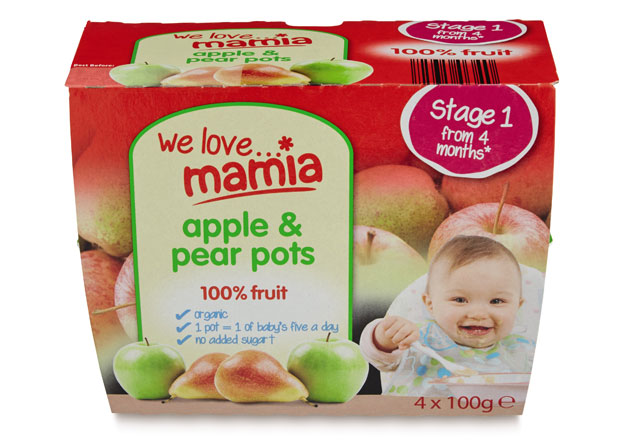 In this case, the first portion of the new product should be half a teaspoon. A full serving is 50 g. It must be remembered that fish can cause allergies if you start giving it to a child earlier.
In this case, the first portion of the new product should be half a teaspoon. A full serving is 50 g. It must be remembered that fish can cause allergies if you start giving it to a child earlier. Pumpkin can be added to vegetables. You can also cook borscht and offer it to your baby in the form of mashed soup. To "desserts" you can add berry puree, yogurt and cookies for children.
11 months
You can expand the diet of cereals. Now you can add semolina, oatmeal, wheat, barley porridge. Also at this time, you can serve puree soups with the addition of finely chopped fresh herbs grown on the window or in the garden. At the same time, you can start feeding your baby bread with butter.
12 months
Juices can be administered during this period. Juice is best prepared at home and fresh fruit and diluted with water in a ratio of 1:1.
 Milk can be added to dairy products. Purees and cereals can be salted using iodized salt.
Milk can be added to dairy products. Purees and cereals can be salted using iodized salt. What are food allergens?
Gluten
Found in oats and rye. In order not to cause an allergic reaction to gluten, you must first introduce gluten-free cereals: rice, buckwheat, corn. Other cereals, breads and biscuits should be introduced after 9 months.
Cow's milk
Until the age of one, the body of a child cannot properly absorb cow's milk. When preparing porridge with milk, you need to use mother's milk.
Eggs
Only small amounts of yolk can be given to a child up to one year old, since a very common occurrence in children under one year old is an allergy to protein.
Bright vegetables and fruits
Vegetables, fruits and berries in red, orange and yellow colors can cause allergies.



